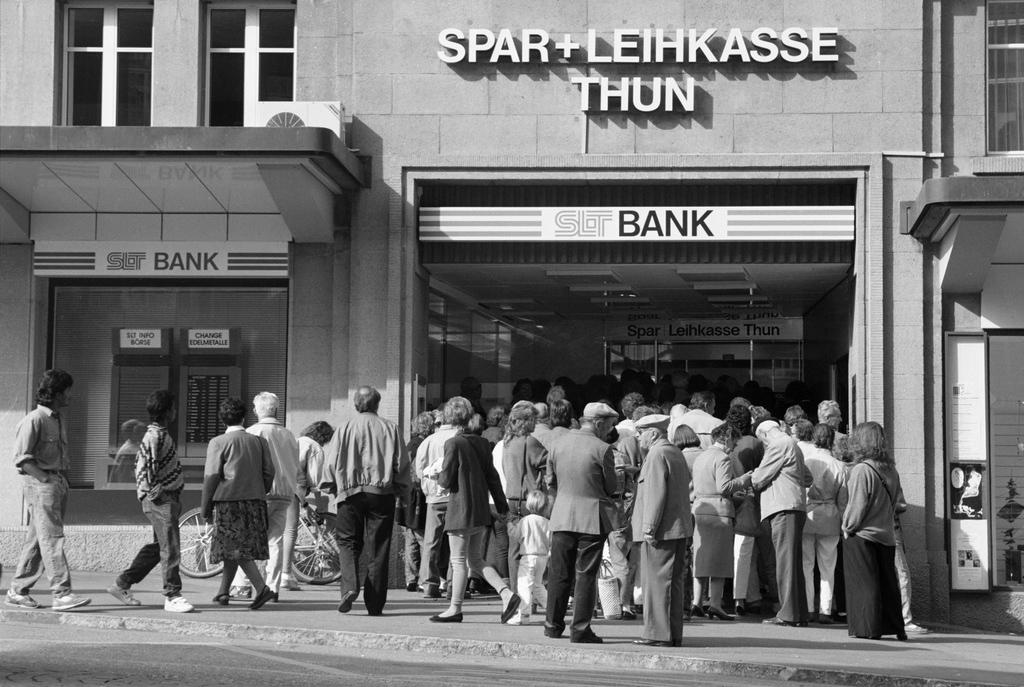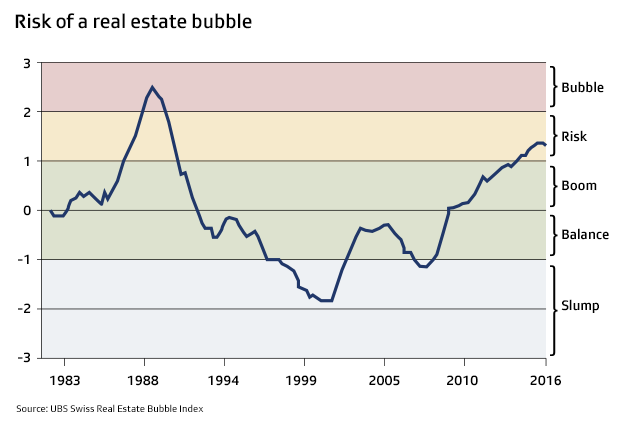
Could there be another bank run in Switzerland?

The images went around the world: 25 years ago, customers of the Spar- und Leihkasse Thun queued up clutching their savings books in an attempt to salvage at least a part of their savings. Many customers lost a big chunk of their assets. Could a bank run like that happen again today?
For those affected, it was a dramatic turn of events when the regulator withdrew the licence of the Spar- und Leihkasse Thun (SLT) in the Bernese Oberland in 1991. Kurt-Peter Schweizer for example, a customer of the bank, experienced the bankruptcy at very close quarters. As a porter in the parliament building, where the banking commission’s press conference on the forced closure of the bank was held, he had to welcome the visitors – including those responsible at the SLT. “That was the worst moment of my life so far. I had to fight to control myself.”

More
A bank defaulting in Switzerland – could it happen again?
The reason for the SLT’s demise was overly lax credit conditions for property purchases. When the property bubble burst at the end of the 1980s, it prompted the bank’s collapse. Some of the underlying conditions today bear similarities with those of that time. Whether there could be a crash like that of the SLT again depends primarily on five factors.
1. The business model
The business model of a retail bank – a bank which deals with small businesses and private customers – largely consists of taking savings and distributing them to other customers as credit. The interest received by the saver is lower than the interest debtors must pay. The difference, the interest margin, is the bank’s profits. If a bank spreads its activities – for example also provides services such as asset management or trading – then the risk that a property crash could cause the bank to falter is lower. Today Swiss retail banks earn two-thirds of their revenue through interest. Twenty years ago, it was 72%, so diversification has clearly increased.
2. Interest-rate movements
At the moment, interest rates are very low. The median yearly rate for a two-year mortgage is about 1%. This means that the banks earn less, because they can’t lower the interest rate on a retail customer’s savings account to below zero. What would be dangerous is if interest rates suddenly increased. Because loans have a longer life-span on average than the period of notice for redeeming savings, a bank could rapidly find itself operating a large loss-making business. The Swiss National Bank, however, is aware of this. It would fight against a sharp jump in interest rates, but its powers are limited.
3. Property prices
Before the SLT’s bankruptcy, the property market was booming. After stock markets crashed in 1987, many investors put their money in property, which caused prices to spiral. There are parallels today: Swiss property prices are increasing because investors see few other investment options, given low interest rates and lacklustre stock markets.
UBS bank analyses the market regularly, and the risk of a property bubble is once again almost as high as at the end of the 1980s.

4. Rules on capital
The financial markets regulator demands that the banks keep enough capital in reserve for emergencies. How high this reserve should be depends on many factors and is subject to complicated calculations. Of course, these regulations only work if they are adhered to. With SLT, that was not the case, although regulators didn’t scrutinise the banks as closely then as they do today.
The Swiss financial market regulator has tightened its grip in the wake of the property crisis 25 years ago and the financial crises before the turn of the last decade. The capital requirements are higher and more closely scrutinised. In addition, the banks are setting more rules themselves, for example concerning conditions for mortgage loans.
5. Depositor Protection Scheme
If a bank were to go bankrupt today, customers’ savings are insured up to the amount of CHF100,000. SLT customers didn’t benefit from this because the Depositor Protection Scheme was only established in 2005. This insurance doesn’t directly reduce the risk of a bank collapse, but it does indirectly: If customers know that they will get their savings back even in an emergency, they will respond more calmly if the bank gets into trouble. It’s possible they wouldn’t then withdraw all their money at once.
Conclusion
Interest rate levels and high property prices are worrying. But the Swiss banking sector has learnt from previous crises. Their business models are built on wider foundations and the regulator demands a more secure safety net. A bank run can never be completely ruled out, but the risk of it happening in Switzerland at the moment is low.
Do you still trust Swiss banks? Would you pay your money into a Swiss bank account? We are interested in your view.
Translated from German by Catherine Hickley

In compliance with the JTI standards
More: SWI swissinfo.ch certified by the Journalism Trust Initiative





























You can find an overview of ongoing debates with our journalists here . Please join us!
If you want to start a conversation about a topic raised in this article or want to report factual errors, email us at english@swissinfo.ch.